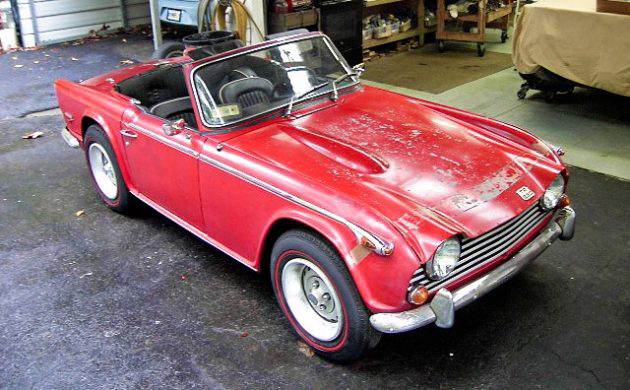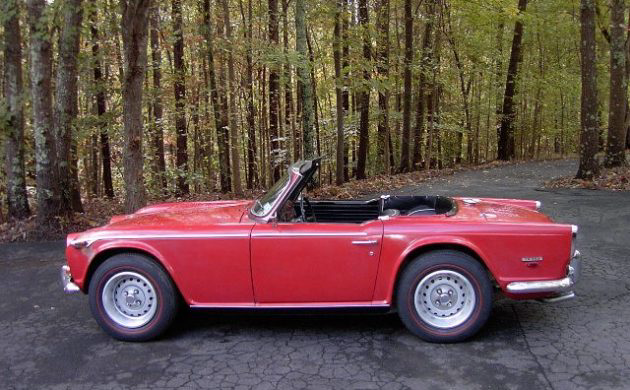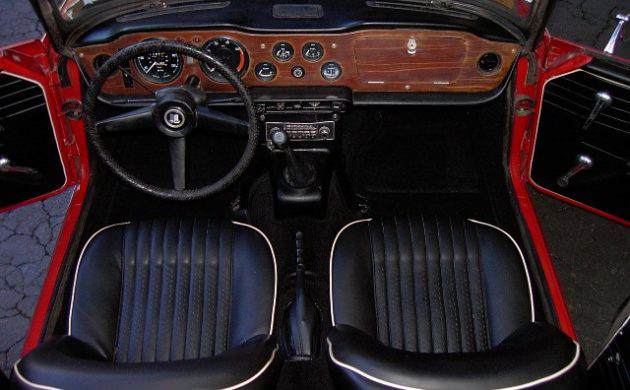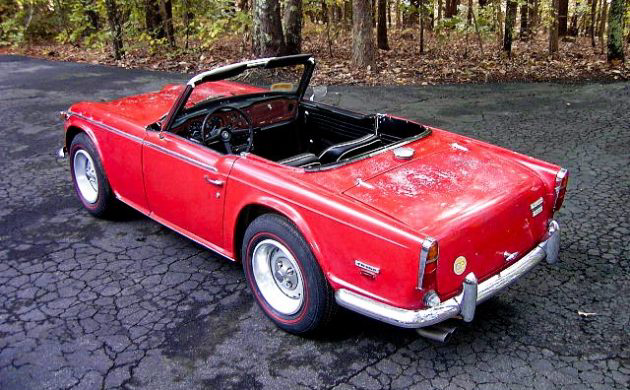While it might be looking tired in a few spots, the Signal Red paint that graces the panels of this 1968 Triumph TR250 is said to be original. In fact, this is a British classic that seems to combine equal quantities of originality with a few very welcome upgrades. If you would like to become the owner of a one-year-only classic, then you will find the TR250 located in Canton, Georgia, and listed for sale here on eBay. Bidding has reached $21,000, but the reserve hasn’t been met.
For the UK market, Triumph produced the TR5 as the replacement for the TR4, but for the US market, this new model underwent a few mechanical changes and was sold as the TR250. The first TR250 rolled off the production line in August of 1967, while the last one was produced in September of 1968. During its 13-month production run, 8,484 cars managed to find their way to the USA. In fact, the US-market TR250 outsold the UK-market TR5 to the tune of around 3-to-1. This one is a solid and clean example with no rust issues. There are some areas of pitting and surface corrosion present, but no rot that has penetrated the original steel. The external trim and chrome appear to be in nice condition, and I suspect that it would respond well to a bit of work with a quality polishing compound. The original top is still present, and while the frame is in good condition, the top itself is showing some deterioration. If the next owner is determined to keep the car original, replacing the rear window would make the top quite serviceable. However, I would be inclined to replace the top to ensure that it provides decent protection if the car gets caught out by wet weather.
The interior of the Triumph is something of a revelation, because if you ignore the wrap on the wheel, what you are looking at is a 100% original interior. The upholstered surfaces appear to be close to faultless, and the same would appear to be true of the carpet. In fact, the only issue to note is some obvious deterioration of the finish on the timber dash. This is not at all unusual, and in fact, this is not as bad as some that I’ve seen. Replacement timber is available, but a competent cabinetmaker should be able to restore the original finish and luster without too many problems.
Now we delve into the area of the Triumph where a few changes have been made. The engine is the original, numbers-matching, 2,498cc straight-six engine, but just what its power output is would seem to be a little vague. It should be 104hp, but when the car was brand new, the engine was treated to some work by a company in the UK called SAH Accessories, who were a Triumph tuning specialist. The engine was dismantled, blueprinted, and balanced. This was all done by the original owner with a view to undertaking some competition work. The engine remained untouched until recently when it was stripped, over-bored, and once again, it was blueprinted and balanced. The engine has essentially done no work since its latest refresh, but the owner does say that it is smooth and strong. The Triumph was originally built with the standard 4-speed manual transmission, but when the first owner was having the engine upgrades performed, he also had the optional manual transmission with overdrive fitted to the car. This is said to work perfectly, meaning that this is a car that is strong both physically, and mechanically.
British sports cars from the 1950s and 1960s possessed two major characteristics. The first of these was that in spite of a general lack of engine power, they were usually engaging and rewarding vehicles to drive. The second was that if exposed to ongoing wet weather, they could also dissolve faster than a teaspoonful of sugar. That is why it is believed that of the original 8,500 cars produced, only around 600-700 are estimated to exist today. Finding a good one is becoming increasingly difficult, but any that have survived largely unaffected by rust to this day should certainly be considered to be a good one. In fact, if they are rust-free now, then the chances are pretty good that if properly cared for, they should remain that way for many years to come. Good examples can be found for around the $25,000 mark, but a pristine one can push up to as high as $40,000. This one fits part-way between those two figures, but its condition is such that it wouldn’t take a huge amount of work to return it to a pristine state. Even as it is, it looks like it would be a fun little British classic to own and drive.







Canton? Must be Dave….but where’s the orange and red blanket in the auction pictures? Lol
Nice car!
This is rolling on TR6 wheels
the first one i saw years ago was in Valencia blue over black, with a silver-white bonnet stripe. have lusted after them ever since.
So, all that work by SAH and its gone? The triple Webers, SAH valve covers etc appear to be gone. At least replace the SAH with a chrome cover as stock for the 250. Some other things as well. For all the pitch about low miles and originality, I’d want to see it in person.
The six through the TR6 had the dual carbs. If the original engine work was done in the UK then what’s on there is probably rejetted non smog which are good units. The TR6 wheels with the oversize tires don’t quite look right on this car. Still, it’s a nice piece.